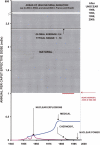Observations on the Chernobyl Disaster and LNT
- PMID: 20585443
- PMCID: PMC2889503
- DOI: 10.2203/dose-response.09-029.Jaworowski
Observations on the Chernobyl Disaster and LNT
Abstract
The Chernobyl accident was probably the worst possible catastrophe of a nuclear power station. It was the only such catastrophe since the advent of nuclear power 55 years ago. It resulted in a total meltdown of the reactor core, a vast emission of radionuclides, and early deaths of only 31 persons. Its enormous political, economic, social and psychological impact was mainly due to deeply rooted fear of radiation induced by the linear non-threshold hypothesis (LNT) assumption. It was a historic event that provided invaluable lessons for nuclear industry and risk philosophy. One of them is demonstration that counted per electricity units produced, early Chernobyl fatalities amounted to 0.86 death/GWe-year), and they were 47 times lower than from hydroelectric stations ( approximately 40 deaths/GWe-year). The accident demonstrated that using the LNT assumption as a basis for protection measures and radiation dose limitations was counterproductive, and lead to sufferings and pauperization of millions of inhabitants of contaminated areas. The projections of thousands of late cancer deaths based on LNT, are in conflict with observations that in comparison with general population of Russia, a 15% to 30% deficit of solid cancer mortality was found among the Russian emergency workers, and a 5% deficit solid cancer incidence among the population of most contaminated areas.
Keywords: Chernobyl; LNT; health effects; irradiation; remedial measures; social consequences.
Figures




Similar articles
-
Third annual Warren K. Sinclair keynote address: retrospective analysis of impacts of the Chernobyl accident.Health Phys. 2007 Nov;93(5):383-409. doi: 10.1097/01.HP.0000282109.20364.37. Health Phys. 2007. PMID: 18049216 Review.
-
One-Decade-Spanning transgenerational effects of historic radiation dose in wild populations of bank voles exposed to radioactive contamination following the chernobyl nuclear disaster.Environ Res. 2020 Jan;180:108816. doi: 10.1016/j.envres.2019.108816. Epub 2019 Oct 9. Environ Res. 2020. PMID: 31627157
-
30 years After the Chernobyl Nuclear Accident: Time for Reflection and Re-evaluation of Current Disaster Preparedness Plans.J Urban Health. 2016 Jun;93(3):407-13. doi: 10.1007/s11524-016-0053-x. J Urban Health. 2016. PMID: 27130482 Free PMC article.
-
Consequences and countermeasures in a nuclear power accident: Chernobyl experience.Biosecur Bioterror. 2012 Sep;10(3):314-20. doi: 10.1089/bsp.2012.0019. Epub 2012 Aug 1. Biosecur Bioterror. 2012. PMID: 22853775
-
Radiation exposure and breast cancer: lessons from Chernobyl.Conn Med. 2013 Apr;77(4):227-34. Conn Med. 2013. PMID: 23691737 Review.
Cited by
-
Thyroid Cancer in Regions Most Contaminated after the Chernobyl Disaster.J Biomed Phys Eng. 2024 Jun 1;14(3):299-308. doi: 10.31661/jbpe.v0i0.2402-1722. eCollection 2024 Jun. J Biomed Phys Eng. 2024. PMID: 39027710 Free PMC article.
-
On the radiation-leukemia dose-response relationship among recovery workers after the chernobyl accident.Dose Response. 2013 Jul 25;12(1):162-5. doi: 10.2203/dose-response.13-031.Jargin. eCollection 2014 Jan. Dose Response. 2013. PMID: 24659940 Free PMC article. No abstract available.
-
Thyroid cancer after Chernobyl: mechanisms of overestimation.Radiat Environ Biophys. 2011 Nov;50(4):603-4; author reply 605-6. doi: 10.1007/s00411-011-0379-4. Epub 2011 Aug 20. Radiat Environ Biophys. 2011. PMID: 21858516 No abstract available.
-
Reconsidering Health Consequences of the Chernobyl Accident.Dose Response. 2015 May 4;13(1):dose-response.14-040.Socol. doi: 10.2203/dose-response.14-040.Socol. eCollection 2015 Jan-Mar. Dose Response. 2015. PMID: 26674769 Free PMC article.
-
Special issue introduction.Dose Response. 2010 Jan 4;8(2):122-4. doi: 10.2203/dose-response.09-060.Scott. Dose Response. 2010. PMID: 20585441 Free PMC article. No abstract available.
References
-
- ACS 2009Tumor markers American Cancer Societyhttp://www.cancer,org/docroot/PED/content/PED_2_3X_Tumor_Markers.asp
-
- Akslen LA, Naumov GN. Tumor dormancy - from basic mechanisms to clinical practice. Acta Pathologica, Microbiologica et Immunologica Scandinavica Special Issue: Tumor Dormancy. 2008;116:545–547. - PubMed
-
- Altius D. Natural Disaster. 2008. http://www.altiusdirectory.com/Science/natural-disaster.html
-
- ApSimon HM, Goddard AJH, Wrigley J, Crompton S. Long-range atmospheric dispersion of radioisotopes - II. Application of the MESOS model. Atmospheric Environment. 1985;19:113–125.
-
- ApSimon HM, Wilson JJN. Modelling Atmospheric dispersal of the Chernobyl release across Europe. Boundary-Layer Meteorology. 1987;41:123–133.
LinkOut - more resources
Full Text Sources

